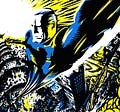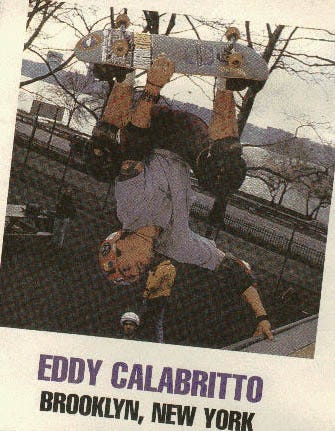June 1996 saw the release of the greatest industrial album ever released. That was KMFDM’s Xtort album, dedicated to the late Wax Trax! co-founder, Jim Nash. It’s hard to exactly call KMFDM an “industrial band,” considering that founder Sascha Konietzko had something else in mind what he would consider “industrial” music.
The album sold over 200,000 copies, and yet according to the liner notes of the 2007 CD reissue,
“[Xtort] brought KMFDM their highest chart position ever, breaking Billboard Top 100, an achievement which Sashca emphatically describes as: '‘truly meaningless.’”1
According to Konietzko’s feelings at the time,
“I hated all the attention, interviews, photo shoots, etc. It seemed to dilute the directness of what I had in mind, ruining the ‘underground cred’ I had been working so hard to establish. I consider myself now faced with the challenge of undoing what had happened, I wanted to throw a wrench into our own system.”2
Konietzko is no stranger to underground music. He came from the German art world and saw KMFDM as an act rather than a traditional band.
In Jon Wiederhorn’s words for the Rolling Stone magazine at the time,
“KMFDM have evolved from an obscure concrete-bashing, art-terrorist outfit to a state-of-the-art industrial-rock band.”3
And with big ambitions,
“Xtort has the potential to be this year's Pretty Hate Machine.”
Yes. Xtort was on its way to being that of Nine Inch Nails.
It’s not remembered particularly for being pop and polished, but rather as dirty and destructive.
Accordingly,
“Inspired by the burgeoning digital hardcore sound he had recently been exposed to while touring in Europe with Atari Teenage Riot, Sascha desired a harsher more intense approach.”4
Sascha writes,
“We literally worked day and night in 24-hour shifts. It was intense and liberating at the same time. I had made the record I wanted to make. I was just so over the diva-ness of my ex-cohorts. Glad that they weren’t involved any longer, I found I could push things harder and harder this time. The result is what has become my favorite KMFDM album of the ’90s.”5
Xtort isn’t exactly a “digital hardcore” release either. I would consider it to be more of an achievement in hatecore and political radicalness.
Sascha acknowledged that,
“I love to destroy things just for the fun of it… I'm like a little kid who tramples his toys, then wants new stuff."
And,
“‘I'm not tortured at all - I'm angry,’ Konietzko says. ‘But I'm laughing about it. When I wake up in the morning, I feel good. I feel like there’s more wrenches to throw in the system and more bombs to drop on people's desks. So I just get ready, grab my cigarettes and go have fun.’”6
This anger and freeform chaos is a stable of the Xtort sound.
Wiederhorn details Sascha’s history,
“Konietzko's work ethic stems partially from his German upbringing. Born to an educated middle-class family in Hamburg, in 1961, he was still a child when his parents divorced. Since his mother wasn't financially secure, he spent his teens working menial jobs to help put food on the table. During those years, he took a lot of speed, drank too much, and drifted aimlessly until a 1976 Sex Pistols gig gave him a renewed sense of purpose. "The next day I shaved off my hair and became a punk," Konietzko recalls, “it was a fucking revelation that made me think everybody can be up on that stage. You don't have to be David Bowie or T. Rex. You can just be a regular guy and play bass and destroy shit."7
“Destroying shit” is a great thesis to make art.
Konietzko’s father is Boris Kegel-Konietzko, an early African art collector in Germany. Sascha commented, “I grew up in a household where we played a lot of African music.”8 The tribal sounds of improvising and organic layers helped Sascha construct a new music theory, that a single sound comes first, and one builds upon it till it becomes something else. Sascha was influenced by seeing D.A.F. and SPK live in his early years, and this convinced him to make something “new” in performative music. Armed with a sampler and a software sequencer from his brother’s Commodore 64, Sascha would record anything that he found fancy, such as a record of a kitchen sink hitting a wall.9 This would be the beginning of KMFDM, and how he would eventually construct the Xtort album in 1996.
While Xtort was intended for CD, it’s a must-have for vinyl and cassette collectors.
The first track on Xtort, “Power,” is thrash metal perfection. Günter Schulz provides a memorable guitar intro, as well as an incredibly harsh, beatdown riff along with stutter glitch drum machine hits. Cheryl Wilson’s gospel voice provides a confusion of queerness in the identity of macho hardcore music.
“Apathy” is a highlight. A speed metal anxiety that urges listeners to fight against laziness and social control. A straight-edge jolt of direct action. The opera breakdown and the beatdown conclusion are also fantastic.
“Rules” is a classic. A dreadful “magic carpet ride to hell” where “the rules do not apply.” More mechanical riffs, a Bruce Breckenfeld organ jam, and cries of female energy.
“Craze” is a voice against the mundaneness of mediocrity. The subtle “anger” against the common people is expressed. What is alien is the stupidity of society. The lone wolf is the only thing that matters.
“Dogma” is amazing. A spoken word landscape akin to the work of Boyd Rice’s “Hatesville.” Wordplay, political meditation, and hatred are the common themes. This track is bound to start a revolution, and no one asked for it! (It also ends Side A on both vinyl and cassette releases).
“Inane” is a real KMFDM anthem. It collages previous songs into one ditty. The structure is unpredictable, and the noise is a headbanger.
“Blame” is not ska, and it isn’t exactly punk. The genre confusion between goth and metal is apparent. The horn selection is delicate. It’s something I never heard before, and gives into Sascha’s theory of the “new.”
“Son of a Gun” is the closest KMFDM will ever get to the digital hardcore sound or breakcore. The perfect in and out of the guitar riff, amen break, and distorted breaks are what KMFDM is about. This track is still played during live sets and is one of my favorite KMFDM songs of all time. The bass and loudness are intense. This is the future of rock music; sheer futuristic and punk-like electronics.
“Ikons” is a great jam. The horror, sadness, and drive make it a track unlike anything KMFDM has ever produced. Lyrics remain stable to the band’s identity and the marching attacks the listener’s perception.
“Wrath” is a legendary anthem. It’s about being a “devil” for the sake of it, making the track exactly 6:66s long. Everything about this song is so good. “Who is who? Who the hell are you?” And, “Do you really love me?” “I’m the devil in disguise.” The main guitar lead, the synth breakdown, the orchestrated sample hits, and the noise conclusion fit together as a single piece. It's the hardest ending track on an album I’ve ever heard. The album ends with a chilling sample, “Is it safe to go home now?”
And then there is “Fairy,” which is originally a secret track on the CD and cassette release. Jr. Blackmail provides a dark fairy tale about rape and violence, although intended to be a humorous piece. The echoes of Andrea Dworkin or Peter Sotos are on this one. A twisted track that wasn’t meant to be listened to after Wrath, providing a new perspective on a fucked-up album for a misanthropic audience.
Xtort is a masterpiece. There is no bad track on this album. Every track earns 5 out of 5 stars. It’s hard to put into words how good this 48-minute 1996 summer album is. It’s brutally the best album I’ve ever listened to. Xtort is what got me into radical politics, transgressive art, and anti-liberal expression in the first place. No album like this has ever been made after this. It’s KMFDM’s best album, and also their most controversial one.
It deserves the title of the greatest industrial album of all time even if it’s not industrial. The energy, aesthetics, subculture, theory, and sound are uniquely original, and nothing else can beat it. KMFDM has created the most evil album ever produced.
For these reasons alone, I love KMFDM, and this work of sacred art belongs in a museum. This is what it means to be anti-liberal.
-pe
1-2-2024
Xtort 2007 CD release liner notes, Metropolis records.
Ibid., [2].
Jon Wiederhorn, Rolling Stone, http://www.waste.org/~alone/kmfdm/rsinterview.html
Ibid., [1].
Ibid., [1].
Ibid., [3].
Ibid., [3].
Jake ‘The Voice’ Parr, KMFDM Interview feat. Sascha Konietzko - The Cyber Den, Dec 14th, 2023, https://www.youtube.com/watch?v=kMjq3O6tOWk
Ibid., [3].






